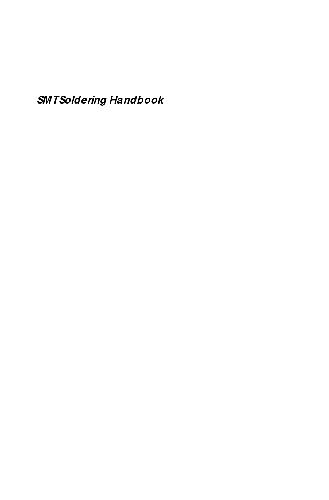Rudolf Strauss0-7506-1862-0
Table of contents :
Contents……Page 5
Preface to the first edition……Page 12
Preface to the second edition……Page 14
Glossary……Page 16
1 Why SMDs?……Page 19
References……Page 23
2.1.1 Melfs and chips……Page 24
2.1.2 LCCCs……Page 26
2.2 High-pincount components……Page 27
2.2.1 TABs……Page 28
2.2.2 Flip-chips and BGAs……Page 29
2.3 Multichip modules……Page 31
2.4.1 Melfs and chips……Page 32
2.4.2 Components with legs……Page 33
2.6 The popcorn effect……Page 34
2.7 References……Page 36
3.1.1 The roles of solder, flux and heat……Page 38
3.1.2 Soldering methods……Page 39
3.2.1 Constituents, melting behaviour and mechanical properties……Page 42
3.2.2 Composition of solders for use in electronics……Page 45
3.2.3 Lead-free solders……Page 47
3.2.4 Solder impurities……Page 49
3.3.1 Soldering as a surface reaction between a molten and a solid metal……Page 55
3.3.2 Structure and characteristics of the soldered joint……Page 56
3.3.3 Mechanical properties of soldered joints……Page 58
3.3.4 Soldering on surfaces other than copper……Page 59
3.3.5 Long-term behaviour of soldered joints……Page 61
3.3.6 Long-term reliability of soldered joints……Page 62
3.4.1 Tasks and action of the soldering flux……Page 63
3.4.2 Wetting and interfacial tension……Page 65
3.4.3 Properties required in a flux……Page 66
3.4.4 Rosin fluxes……Page 68
3.4.5 Low-solids and no- clean fluxes……Page 70
3.4.6 Watersoluble fluxes……Page 71
3.4.8 Flux standards……Page 72
3.4.9 Testing soldering fluxes……Page 75
3.5.1 Heat requirements and heat flow……Page 78
3.5.2 Heating options……Page 79
3.6.1 Wetting and dewetting……Page 81
3.6.3 Capillarity and joint configuration……Page 83
3.6.5 Oxide layers……Page 87
3.6.6 Solderability-enhancing surface coatings……Page 89
3.6.7 Leaching effect of molten solder……Page 91
3.6.8 Measuring solderability……Page 92
3.7 References……Page 99
4.1.2 Wavesoldering after SMDs……Page 102
4.2 Applying the flux……Page 103
4.2.1 Types of fluxer……Page 105
4.2.2 Monitoring and controlling flux quality……Page 114
4.3.1 Heat requirements……Page 116
4.3.2 Heat emitters and their characteristics……Page 118
4.3.3 Temperature control……Page 120
4.4.1 Construction of the soldering unit……Page 121
4.4.2 Thermal role of the solderwave……Page 122
4.4.3 Interaction between molten solder and the circuit board……Page 123
4.4.4 Chipwaves……Page 128
4.4.5 Formation and control of dross……Page 132
4.5.1 Origins and development……Page 136
4.5.2 Wavesoldering in nitrogen……Page 137
4.6.2 Board-handling systems……Page 144
4.7.1 Operating parameters and their role……Page 148
4.7.2 Choosing and monitoring operating parameters……Page 149
4.7.3 Optimizing machine parameters……Page 154
4.7.4 Machine maintenance……Page 155
4.7.6 Dealing with dross……Page 156
4.7.7 Hygiene and safety……Page 157
4.8.2 Storage and handling behaviour of adhesives……Page 159
4.8.3 Applying the adhesive……Page 161
4.8.4 Curing the adhesive joint……Page 163
4.8.5 The glass transition temperature……Page 164
4.9 References……Page 165
5.1.1 SMDs and reflowsoldering……Page 166
5.1.2 Reflowsoldering versus wavesoldering……Page 172
5.2.1 Operational requirements……Page 176
5.2.2 Standard specifications……Page 177
5.2.3 Solderpowder……Page 178
5.2.4 The flux and its residue……Page 182
5.2.5 Printing and dispensing properties……Page 183
5.2.6 The solderball test……Page 185
5.3.1 Single-spot dispensing……Page 187
5.3.2 Stencilling and screen printing……Page 189
5.3.3 Depots of solid solder……Page 196
5.4.1 The basic concept……Page 197
5.4.3 The physics of vapourphase soldering……Page 198
5.4.4 Vapourphase soldering equipment……Page 202
5.4.5 ‘New-generation’ vapourphase soldering systems……Page 204
5.5.1 Working principle……Page 207
5.5.2 The physics of heat transfer by radiation……Page 209
5.5.3 The physics of heat transfer by convection……Page 218
5.5.4 Operation of infrared ovens……Page 219
5.5.5 Oven design……Page 221
5.5.6 Infrared soldering in a controlled atmosphere……Page 226
5.6.1 Convection versus radiation……Page 227
5.6.3 Convection reflow ovens……Page 228
5.6.4 Development potential of convection reflowsoldering……Page 230
5.6.5 Convection soldering of single components……Page 232
5.7 Laser soldering……Page 235
5.7.2 Nd: YAG and CO2 lasers……Page 236
5.7.3 Laser soldering in practice……Page 238
5.7.4 Laser-soldering equipment……Page 239
5.8.1 Operating principle……Page 241
5.8.2 The solder depot……Page 242
5.8.3 The thermode and its heating cycle……Page 243
5.8.4 Impulse-soldering equipment……Page 245
5.9 SMD soldering methods – A survey……Page 246
Vapourphase soldering……Page 247
Convection soldering of single components……Page 248
Impulse soldering of single components……Page 249
5.10 References……Page 250
6.2 SMD-specific demands on a circuit board……Page 252
6.3 Thermal management……Page 254
6.3.2 Effects of temperature differences between components and board……Page 255
6.4 Solderable surfaces……Page 256
6.4.2 Hot tinning……Page 257
6.4.3 Organic coatings……Page 259
6.4.4 Flat solder depots……Page 260
6.6.1 Layout for wavesoldering……Page 262
6.6.2 Layout for reflowsoldering……Page 265
6.7 References……Page 267
7.1 The task……Page 268
7.2 Reliability of placement……Page 269
7.3.1 Fully manual placement……Page 271
7.3.2 Semi- automatic placement……Page 273
7.3.3 Fully automatic sequential systems……Page 274
7.3.4 Simultaneous placement systems……Page 275
7.4.1 The range of choice……Page 276
7.4.2 Classes of placement machines……Page 277
7.5 Reference……Page 278
8.1 Basic considerations……Page 279
8.1.1 Reasons for cleaning……Page 281
8.1.2 Designing for cleanability……Page 284
8.1.3 What must be removed?……Page 285
8.2.1 The physics of cleaning……Page 287
8.2.2 The chemistry of cleaning……Page 292
8.3 The practice of cleaning……Page 294
8.3.1 Organic solvents……Page 295
8.3.2 Solvent-cleaning installations……Page 300
8.3.3 In-line cleaning plants……Page 306
8.3.4 Halogenated solvents: safety and health……Page 309
8.3.5 The three environmental threats……Page 311
8.3.6 Restrictions on solvent usage……Page 315
8.3.7 Non-flammable organic solvents with reduced environmental risks……Page 316
8.3.8 Flammable solvents……Page 317
8.4.1 Chemical and physical aspects……Page 320
8.4.2 Water quality……Page 321
8.4.3 Water recycling and effluent problems……Page 323
8.4.5 Removal of residue from resinous fluxes……Page 324
8.4.6 Water washing installations……Page 325
8.5.1 The concept……Page 328
8.5.2 The cleaning solvents……Page 329
8.5.3 Semi-aqueous washing installations for water- immiscible solvents……Page 331
8.5.4 Semi-aqueous washing installations for water- miscible solvents……Page 333
8.6.1 The meaning of cleanliness……Page 336
8.6.2 Measuring ionic contamination (MIL test)……Page 337
8.6.3 Measuring surface insulation resistance (SIR)……Page 339
8.7 The future of cleaning and of fluxing……Page 340
8.8 References……Page 341
9.1.1 Product quality and product reliability……Page 343
9.1 The meaning of ‘quality’……Page 0
9.1.2 Classification according to reliability requirements……Page 344
9.2.1 Soldering success and soldering faults……Page 345
9.2.2 Soldering perfection and soldering imperfections……Page 348
9.5 Inspection……Page 350
9.5.1 When to inspect……Page 353
9.5.2 Visual inspection……Page 355
9.5.4 X-ray inspection……Page 356
9.6 References……Page 358
10.1.1 Rework in the production process……Page 360
10.2.1 Metallurgical and mechanical consequences of rework……Page 361
10.2.3 Lessons to be learned……Page 362
10.3.1 Heat sources……Page 363
10.3.2 Rework stations……Page 365
10.4.2 Desoldering SMDs……Page 366
10.4.3 Filling empty joints……Page 371
10.4.4 Resoldering SMDs……Page 374
10.4.5 Cleaning after rework……Page 376
10.4.6 Semi-mechanized work stations……Page 377
10.5.1 Rework personnel……Page 378
10.6 References……Page 379
Index……Page 381

Reviews
There are no reviews yet.